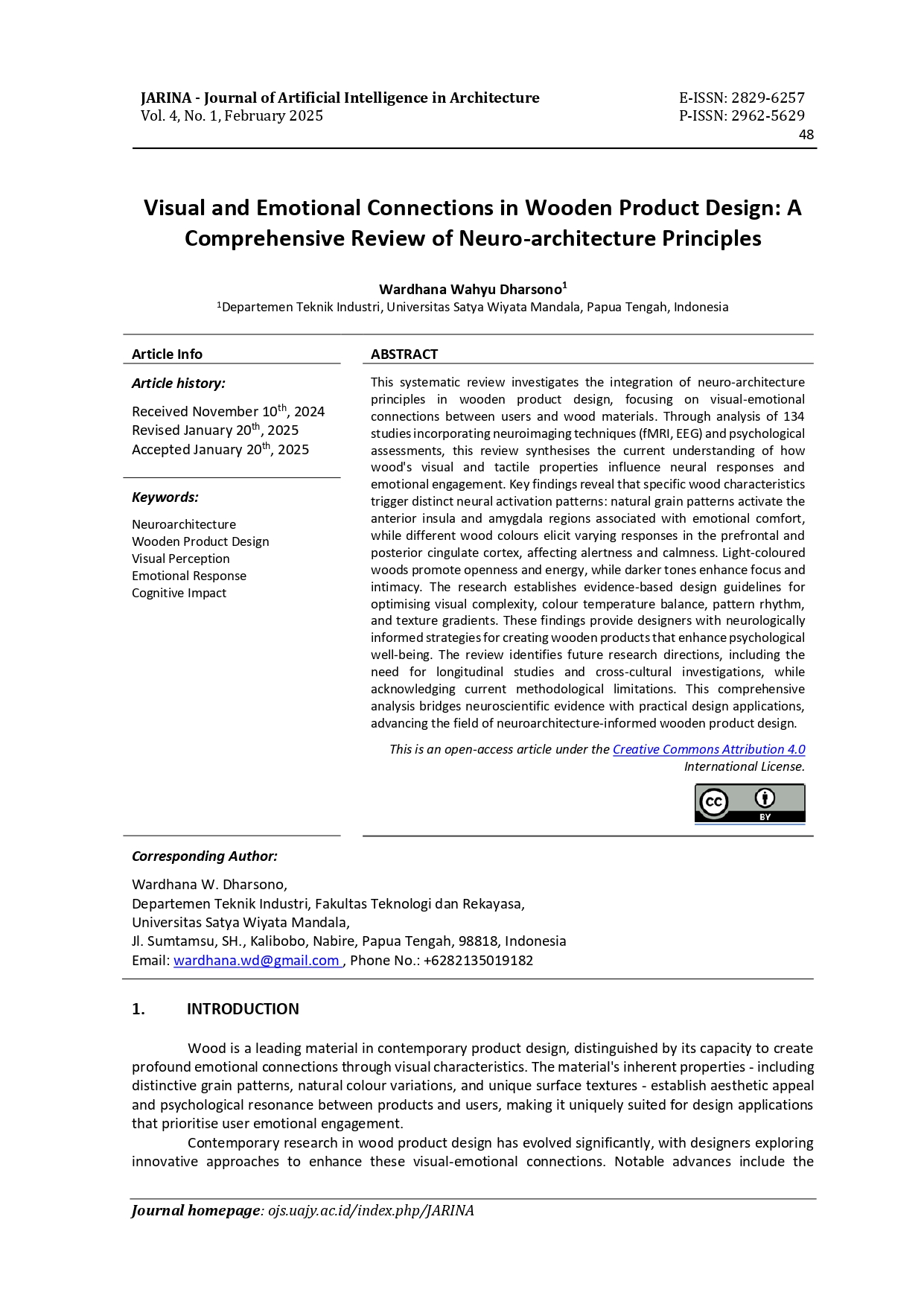Visual and Emotional Connections in Wooden Product Design: A Comprehensive Review of Neuro-architecture Principles
DOI:
https://doi.org/10.24002/jarina.v4i1.10160Keywords:
Neuroarchitecture, Wooden Product Design, Visual Perception, Emotional Response, Cognitive ImpactAbstract
This systematic review investigates the integration of neuro-architecture principles in wooden product design, focusing on visual-emotional connections between users and wood materials. Through analysis of 134 studies incorporating neuroimaging techniques (fMRI, EEG) and psychological assessments, this review synthesises the current understanding of how wood's visual and tactile properties influence neural responses and emotional engagement. Key findings reveal that specific wood characteristics trigger distinct neural activation patterns: natural grain patterns activate the anterior insula and amygdala regions associated with emotional comfort, while different wood colours elicit varying responses in the prefrontal and posterior cingulate cortex, affecting alertness and calmness. Light-coloured woods promote openness and energy, while darker tones enhance focus and intimacy. The research establishes evidence-based design guidelines for optimising visual complexity, colour temperature balance, pattern rhythm, and texture gradients. These findings provide designers with neurologically informed strategies for creating wooden products that enhance psychological well-being. The review identifies future research directions, including the need for longitudinal studies and cross-cultural investigations, while acknowledging current methodological limitations. This comprehensive analysis bridges neuroscientific evidence with practical design applications, advancing the field of neuroarchitecture-informed wooden product design.
References
[1] A. K. Aagaard and N. M. Larsen, “Developing a fabrication workflow for irregular sawlogs,” Int. J. Archit. Comput., vol. 18, no. 3, pp. 270–283, 2020, doi: 10.1177/1478077120906736.
[2] L. Allner and D. Kroehnert, “Natural complexity. An introduction to structural design with tree forks,” Lect. Notes Civ. Eng., vol. 24, no. January, pp. 743–759, 2019, doi: 10.1007/978-3-030-03676-8_29.
[3] R. Mi et al., “Scalable aesthetic transparent wood for energy-efficient buildings,” Nat. Commun., vol. 11, no. 1, pp. 1–9, 2020, doi: 10.1038/s41467-020-17513-w.
[4] Z. Dai, J. Xue, and S. Wang, “Effects of wood texture and color on aesthetic pleasure: two experimental studies,” Int. J. Reconfigurable Embed. Syst., vol. 12, no. 1, pp. 125–134, 2023, doi: 10.11591/ijres.v12.i1.pp125-134.
[5] L. Y. Liu and X. J. Fan, “The Design of System to Texture Feature Analysis Based on Gray Level Co-Occurrence Matrix,” Appl. Mech. Mater., vol. 727–728, pp. 904–907, 2015, doi: 10.4028/www.scientific.net/amm.727-728.904.
[6] D. Ezzat Ahmed, S. Kamel, and L. Khodeir, “Exploring the contribution of Neuroarchitecture in learning environments design ‘A review,’” Int. J. Archit. Eng. Urban Res., vol. 4, no. 1, pp. 67–94, 2021, doi: 10.21608/ijaeur.2021.215924.
[7] J. W. Rowe et al., “Daedalus: What is the Brain Good For?,” J. Am. Acad. Arts Sci., 2015, [Online]. Available: www.amacad.org
[8] E. Elbaiuomy, I. Hegazy, and S. Sheta, “The impact of architectural spaces’ geometric forms and construction materials on the users’ brainwaves and consciousness status,” Int. J. Low-Carbon Technol., vol. 13, no. 1, pp. 43–51, 2018, doi: 10.1093/ijlct/ctx018.
[9] M. Llorens-Gámez, J. L. Higuera-Trujillo, C. S. Omarrementeria, and C. Llinares, “The impact of the design of learning spaces on attention and memory from a neuroarchitectural approach: A systematic review,” Front. Archit. Res., vol. 11, no. 3, pp. 542–560, 2022, doi: 10.1016/j.foar.2021.12.002.
[10] S. Sakuragawa, T. Kaneko, and Y. Miyazaki, “Effects of contact with wood on blood pressure and subjective evaluation,” J. Wood Sci., vol. 54, no. 2, pp. 107–113, 2008, doi: 10.1007/s10086-007-0915-7.
[11] T. Alapieti, R. Mikkola, P. Pasanen, and H. Salonen, “The influence of wooden interior materials on indoor environment: a review,” Eur. J. Wood Wood Prod., vol. 78, no. 4, pp. 617–634, 2020, doi: 10.1007/s00107-020-01532-x.
[12] D. Lipovac and M. D. Burnard, “Effects of visual exposure to wood on human affective states, physiological arousal and cognitive performance: A systematic review of randomized trials,” Indoor Built Environ., vol. 30, no. 8, pp. 1021–1041, 2021, doi: 10.1177/1420326X20927437.
[13] Y. Zhu, Q. Wang, and F. Zhao, “Wood in office spaces: The impact of different wooden furniture on aesthetic evaluation,” Front. Psychol., vol. 13, no. January, pp. 1–12, 2023, doi: 10.3389/fpsyg.2022.986627.
[14] H. Paluš, H. Mat’ová, and V. Kaputa, “Consumer preferences for joinery products and furniture in Slovakia and Poland,” Acta Fac. Xylologiae, vol. 54, no. 2, pp. 123–132, 2012.
[15] O. Høibø and A. Q. Nyrud, “Consumer perception of wood surfaces: The relationship between stated preferences and visual homogeneity,” J. Wood Sci., vol. 56, no. 4, pp. 276–283, 2010, doi: 10.1007/s10086-009-1104-7.
[16] M. Nakamura and T. Kondo, “Quantification of visual inducement of knots by eye-tracking,” J. Wood Sci., vol. 54, no. 1, pp. 22–27, 2008, doi: 10.1007/s10086-007-0910-z.
[17] A. Q. Nyrud, T. Bringslimark, and K. Bysheim, “Benefits from wood interior in a hospital room: A preference study,” Archit. Sci. Rev., vol. 57, no. 2, pp. 125–131, 2014, doi: 10.1080/00038628.2013.816933.
[18] J. PETERSON, M. SHITARA, H. YOSHIDA, M. KAMIJO, G. FUJIMAKI, and H. YAMAGUCHI, “Emotional Differences in Tactile and Visual Sensation of Wood between Customers in Sweden and Japan for Kansei Engineering Application,” Int. J. Affect. Eng., vol. 18, no. 4, pp. 181–188, 2019, doi: 10.5057/ijae.ijae-d-18-00018.
[19] A. Manuel, R. Leonhart, O. Broman, and G. Becker, “Consumers’ perceptions and preference profiles for wood surfaces tested with pairwise comparison in Germany,” Ann. For. Sci., vol. 72, no. 6, pp. 741–751, 2015, doi: 10.1007/s13595-014-0452-7.
[20] T. Ramananantoandro, M. F. Ramanakoto, A. H. Rajemison, and F. Eyma, “Relationship between density and aesthetic attributes of wood and preference of Malagasy consumers,” Ann. For. Sci., vol. 70, no. 6, pp. 649–658, 2013, doi: 10.1007/s13595-013-0299-3.
[21] A. Aloumi, S. Noroozi, B. Eves, and M. Dupac, “The impact of color contrast on the perception of complexity–simplicity of design product,” Int. J. Des. Creat. Innov., vol. 1, no. 4, pp. 233–254, 2013, doi: 10.1080/21650349.2013.773879.
[22] A. Yoonessi and Q. Zaidi, “The role of color in recognizing material changes,” Ophthalmic Physiol. Opt., vol. 30, no. 5, pp. 626–631, 2010, doi: 10.1111/j.1475-1313.2010.00722.x.
[23] S. Silva, B. Sousa Santos, and J. Madeira, “Using color in visualization: A survey,” Comput. Graph., vol. 35, no. 2, pp. 320–333, 2011, doi: 10.1016/j.cag.2010.11.015.
[24] J. Rice, R. A. Kozak, M. J. Meitner, and D. H. Cohen, “Appearance wood products and psychological well-being,” Wood Fiber Sci., vol. 38, no. 4, pp. 644–659, 2006.
[25] S. W. Hsiao and Y. C. Ko, “A study on bicycle appearance preference by using FCE and FAHP,” Int. J. Ind. Ergon., vol. 43, no. 4, pp. 264–273, 2013, doi: 10.1016/j.ergon.2013.04.003.
[26] M. C. Chuang, C. C. Chang, and S. H. Hsu, “Perceptual factors underlying user preferences toward product form of mobile phones,” Int. J. Ind. Ergon., vol. 27, no. 4, pp. 247–258, 2001, doi: 10.1016/S0169-8141(00)00054-8.
[27] M. A. Artacho-Ramírez, J. A. Diego-Mas, and J. Alcaide-Marzal, “Influence of the mode of graphical representation on the perception of product aesthetic and emotional features: An exploratory study,” Int. J. Ind. Ergon., vol. 38, no. 11–12, pp. 942–952, 2008, doi: 10.1016/j.ergon.2008.02.020.
[28] M. De Meijer, “Review on the durability of exterior wood coatings with reduced VOC-content,” Prog. Org. Coatings, vol. 43, pp. 217–225, 2001.
[29] J. E. P. Custódio and M. I. Eusébio, “Waterborne acrylic varnishes durability on wood surfaces for exterior exposure,” Prog. Org. Coatings, vol. 56, no. 1, pp. 59–67, 2006, doi: 10.1016/j.porgcoat.2006.02.008.
[30] J. Van Den Bulcke, J. Van Acker, and M. Stevens, “Experimental and theoretical behavior of exterior wood coatings subjected to artificial weathering,” J. Coatings Technol. Res., vol. 5, no. 2, pp. 221–231, 2008, doi: 10.1007/s11998-007-9074-4.
[31] E. Scrinzi, S. Rossi, F. Deflorian, and C. Zanella, “Evaluation of aesthetic durability of waterborne polyurethane coatings applied on wood for interior applications,” Prog. Org. Coatings, vol. 72, no. 1–2, pp. 81–87, 2011, doi: 10.1016/j.porgcoat.2011.03.013.
[32] R. C. A. Bendall, S. Lambert, A. Galpin, L. P. Marrow, and S. Cassidy, “Psychophysiological indices of cognitive style: A triangulated study incorporating neuroimaging, eye-tracking, psychometric and behavioral measures,” Pers. Individ. Dif., vol. 144, no. November 2018, pp. 68–78, 2019, doi: 10.1016/j.paid.2019.02.034.
[33] M. L. Mele and S. Federici, “Gaze and eye-tracking solutions for psychological research,” Cogn. Process., vol. 13, no. 1 SUPPL, 2012, doi: 10.1007/s10339-012-0499-z.
[34] R. M. Rahal and S. Fiedler, “Understanding cognitive and affective mechanisms in social psychology through eye-tracking,” J. Exp. Soc. Psychol., vol. 85, no. July, p. 103842, 2019, doi: 10.1016/j.jesp.2019.103842.
[35] D. Mamić and D. Domljan, “Positive Aspects of Using Solid Wood in Interiors on Human Wellbeing: A Review,” Drv. Ind., vol. 74, no. 3, pp. 379–391, 2023, doi: 10.5552/drvind.2023.0130.
[36] M. Ritter, K. Skog, and R. Bergman, “Science supporting the economic and environmental benefits of using wood and wood products in green building construction,” p. 15, 2011, [Online]. Available: http://www2.fpl.fs.fed.us/products/publications/display_publications_for_specific_author.php?employee_id=10
[37] M. G. Berman, J. Jonides, and S. Kaplan, “The cognitive benefits of interacting with nature,” Psychol. Sci., vol. 19, no. 12, pp. 1207–1212, 2008, doi: 10.1111/j.1467-9280.2008.02225.x.
[38] M. D. Burnard, A. Q. Nyrud, K. Bysheim, A. Kutnar, K. Vahtikari, and M. Hughes, “Building material naturalness: Perceptions from Finland, Norway and Slovenia,” Indoor Built Environ., vol. 26, no. 1, pp. 92–107, 2015, doi: 10.1177/1420326X15605162.
[39] S. Kaplan, “The restorative benefits of nature: Toward an integrative framework,” J. Environ. Psychol., vol. 15, no. 3, pp. 169–182, 1995, doi: 10.1016/0272-4944(95)90001-2.
[40] D. K. Brown, J. L. Barton, and V. F. Gladwell, “Viewing nature scenes positively affects recovery of autonomic function following acute-mental stress,” Environ. Sci. Technol., vol. 47, no. 11, pp. 5562–5569, 2013, doi: 10.1021/es305019p.
[41] B. Cimprich and D. L. Ronis, “An environmental intervention to restore attention in women with newly diagnosed breast cancer,” Cancer Nurs., vol. 26, no. 4, pp. 284–292, 2003, doi: 10.1097/00002820-200308000-00005.
[42] B. Falk, “Wood as a sustainable building material,” For. Prod. J., vol. 59, no. 9, pp. 6–12, 2009.
[43] M. Burnard, Č. Tavzes, A. Tošić, A. Brodnik, and A. Kutnar, “The role of reverse logistics in recycling of wood products,” Environ. Footprints Eco-Design Prod. Process., pp. 1–30, 2015, doi: 10.1007/978-981-287-643-0_1.
[44] Y. Tsunetsugu, Y. Miyazaki, and H. Sato, “The visual effects of wooden interiors in actual-size living rooms on the autonomic nervous activities,” J. Physiol. Anthropol. Appl. Human Sci., vol. 21, no. 6, pp. 297–300, 2002, doi: 10.2114/jpa.21.297.
[45] Q. Wan, X. Li, Y. Zhang, S. Song, and Q. Ke, “Visual perception of different wood surfaces: an event-related potentials study,” Ann. For. Sci., vol. 78, no. 2, pp. 1–18, 2021, doi: 10.1007/s13595-021-01026-7.

Downloads
Published
How to Cite
Issue
Section
License
Copyright (c) 2025 Wardhana Wahyu Dharsono

This work is licensed under a Creative Commons Attribution 4.0 International License.
Authors who publish with this journal agree to the following terms:
1.Authors retain copyright and grant the journal right of first publication with the work simultaneously licensed under a Creative Commons that allows others to share the work with an acknowledgement of the work's authorship and initial publication in this journal.
2.Authors are able to enter into separate, additional contractual arrangements for the non-exclusive distribution of the journal's published version of the work (e.g., post it to an institutional repository or publish it in a book), with an acknowledgement of its initial publication in this journal.
3.Authors are permitted and encouraged to post their work online (e.g., in institutional repositories or on their website) prior to and during the submission process, as it can lead to productive exchanges, as well as earlier and greater citation of published work (See The Effect of Open Access).
















